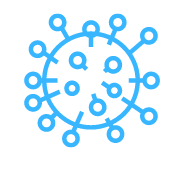What is Pathogen? An Overview
What is a Pathogen?
A pathogen is a microorganism, such as a bacterium, virus, or fungus, that causes diseases in humans, animals, or plants. These pathogens have the ability to invade and infect their host, leading to the development of various illnesses and health conditions. Pathogens can be transmitted through various means, including direct contact with infected individuals, contaminated food or water, or even through the air.
An Overview
An Overview of Pathogens:
Pathogens are microorganisms, such as bacteria, viruses, fungi, or parasites, that can cause disease in their hosts. They have various strategies to survive and multiply within their host, often leading to illness or infection.
Bacteria are single-celled organisms that can be found almost anywhere. While most bacteria are harmless or even beneficial, some can cause infections. Examples of bacteria that can cause diseases include Staphylococcus aureus, Streptococcus pyogenes, and Escherichia coli.
Viruses are much smaller than bacteria and cannot reproduce on their own. They rely on host cells to replicate and cause infection. Common viral diseases include the flu, common cold, measles, and HIV/AIDS.
Fungi, such as yeasts and molds, are also common pathogens. They can cause various infections, ranging from superficial infections like athlete’s foot to more severe systemic fungal infections.
Parasites are organisms that live on or within another organism and rely on them for their survival. They can be divided into two main groups: protozoa and helminths. Protozoa are single-celled organisms, while helminths are larger worms. Examples of parasitic infections include malaria (caused by a protozoa), and intestinal worms (caused by helminths).
Pathogens can be transmitted through various routes, including direct contact with infected individuals, ingestion of contaminated food or water, inhalation of airborne pathogens, or through vectors such as mosquitoes or ticks. The severity of the resulting disease can vary widely depending on various factors, including the pathogen’s virulence and the host’s immune response.
Preventing the spread of pathogens is crucial to controlling infectious diseases. Measures such as good hygiene practices (regular handwashing, proper food handling, and disinfection), vaccination, and the use of antimicrobial drugs where appropriate play a vital role in reducing pathogen transmission and preventing illness.
In conclusion, pathogens are microorganisms that can cause diseases in their hosts. They can be bacteria, viruses, fungi, or parasites, and they have different mechanisms to survive and multiply within their hosts. Understanding these pathogens and implementing effective prevention and control measures is essential in combating infectious diseases.
A Comprehensive Guide
A Comprehensive Guide: Pathogens
Introduction:
Pathogens are microorganisms that can cause disease in humans, animals, and plants. They include bacteria, viruses, fungi, and parasites. Understanding pathogens is essential for preventing and treating infectious diseases. In this comprehensive guide, we will explore different types of pathogens, how they spread, and methods of prevention.
1. Bacteria:
Bacteria are single-celled organisms that can be found in various environments. While many bacteria are harmless or beneficial, some can cause illnesses. Examples of bacterial infections include tuberculosis, strep throat, and urinary tract infections. Antibiotics are commonly used to treat bacterial infections.
2. Viruses:
Viruses are tiny particles that require a host to replicate. They can infect humans, animals, and even plants. Examples of viral infections include the common cold, influenza, and human immunodeficiency virus (HIV). Vaccinations, antiviral medications, and supportive care are often used to manage viral infections.
3. Fungi:
Fungi are organisms that can exist as single-celled yeasts or multi-cellular molds. They can cause infections in humans, especially in individuals with weakened immune systems. Examples of fungal infections include athlete’s foot, ringworm, and vaginal yeast infections. Antifungal medications are typically used to treat these infections.
4. Parasites:
Parasites are organisms that live and feed off another organism, known as the host. They can be found in humans, animals, and plants. Examples of parasitic infections include malaria, lice infestations, and intestinal worms. Treatment for parasitic infections usually involves specific medications targeting the parasite.
How Pathogens Spread:
Pathogens can spread through various routes, including:
– Direct contact: Pathogens can be transmitted through direct physical contact with an infected individual or their bodily fluids, such as through touching, kissing, or sexual intercourse.
– Indirect contact: Pathogens can be transmitted through indirect contact with contaminated objects, such as surfaces, doorknobs, or utensils. Touching these objects and then touching the face or mouth can lead to infection.
– Airborne transmission: Some pathogens can spread through respiratory droplets when a person infected with a respiratory illness coughs or sneezes. Others may remain suspended in the air for extended periods, making inhalation a possible route of transmission.
– Vector-borne transmission: Certain pathogens rely on vector organisms, such as mosquitoes, ticks, or fleas, to transmit the infection from one host to another. Examples include malaria and Lyme disease.
Methods of Prevention:
Preventing the spread of pathogens is crucial for reducing the risk of infection. Here are some effective preventive measures:
– Hand hygiene: Wash hands with soap and water for at least 20 seconds, especially after using the restroom, before eating, and after coughing or sneezing.
– Vaccination: Stay up-to-date on recommended vaccinations as they can prevent many infectious diseases.
– Proper food handling: Practice good food safety techniques, such as washing hands, cooking food thoroughly, and avoiding cross-contamination.
– Safe sexual practices: Use barrier methods, such as condoms, to reduce the risk of sexually transmitted infections.
– Vector control: Protect yourself from vector-borne diseases by using insect repellents, wearing protective clothing, and eliminating breeding grounds for mosquitoes and other insects.
– Stay home when sick: Avoid close contact with others if you are experiencing symptoms of illness to prevent spreading the infection.
Conclusion:
Understanding pathogens and the ways they spread is crucial for preventing and managing infectious diseases. By practicing good hygiene, getting vaccinated, and taking necessary precautions, we can reduce the risk of infection and protect ourselves and others from the harmful effects of pathogens.
